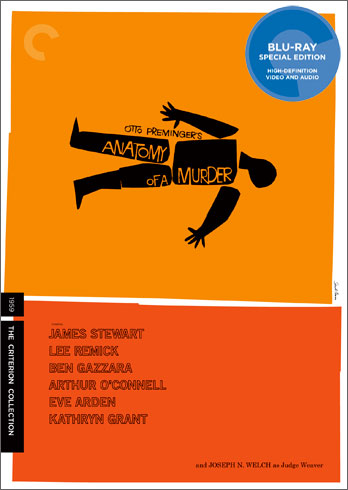
I thought that the Criterion Collection spine number 600 title would be a big deal, some kind of splendid box set or a film that everyone would agree was one of the greatest, most indispensable titles ever. So you can imagine my surprise when it was announced that The Big 600 would be Otto Preminger’s 1959 courtroom drama Anatomy Of A Murder, a movie that I liked, and is supposedly beloved among those in the legal profession (and what a ringing endorsement THAT is), but in all honesty, never really blew my mind. But the very fact that a film I hadn’t even considered for inclusion made it into the Collection intrigued the heck out of me, so I took the Blu-ray for a spin. And as it turns out, I’m really glad I did, because for me this disc exemplifies what makes Criterion release such a valuable resource: the extra features enhanced and deepened my appreciation for Anatomy Of A Murder, so that I have a better understanding of what makes it a worthy addition. You guys, I totally get it now!
The venerable James Stewart stars as Paul Biegler, a small-time Michigan attorney who finds himself defending Frederick Manion (the recently deceased Ben Gazzara), a military hothead who is charged with murdering the man who allegedly raped his comely wife Laura (Lee Remick). Many legal tricks and shenanigans ensue as Biegler attempts to get his client off the hook, but he has a formidable opponent in prosecutor Claude Dancer, played with wily cunning by George C. Scott. All of these actors deliver solid performances, as do Arthur O’Connell and Eve Arden as Biegler’s confederates. Preminger directs skillfully and unobtrusively, aided by many able craftsmen behind the scenes such as cinematographer Sam Leavitt, who achieves a solid documentary feel that is enhanced by a transfer that preserves the film grain; the music is composed by jazz legend Duke Ellington, who also appears in a roadhouse scene wearing what is either a jacket or a test pattern in the shape of a jacket.
Along with the impeccable presentation of the film itself comes several bonus goodies that really show what Criterion can do: at first I felt let down because there was no commentary track, but these features cover a lot of ground. First up: Foster Hirsch, the author of a Preminger biography, weighs in with a half-hour discussion of the film that is very engaging, providing detail that is informative and illuminating. For instance, I knew Joseph N. Welch, who plays the judge in the film, was not an actor (and it shows), but I was entirely unaware that it was he who made the immortal contribution to the Army-McCarthy hearings of the 1950’s that Hirsch describes in his talk.
Elsewhere is a late-’60s excerpt from an episode of the old television talk show Firing Line, which will be of great interest to those who have tired of our current media’s coarse, loudmouth blowhards and would instead like to try a reasonable, erudite blowhard. The late conservative pundit William F. Buckley, whose voice could charitably be described as the sound of paint drying in an elegant drawing room, debates Preminger on the Production Code that the director famously helped to destroy. I defy anyone to not be consumed with a powerful urge to hit Buckley in the face with a pie within seconds of hearing him speak. Fortunately, this bit only lasts about ten minutes, and to be fair, one can derive a wistful nostalgia for the days when people could debate issues on TV in a fair and intelligent manner without erupting into shouting and demagoguery.
Gary Giddins, the very well-regarded jazz critic and writer who also graced Criterion’s DVD for Louis Malle’s Elevator To The Gallows with an excellent discussion of Miles Davis’ score for that film, returns here for a 20-minute talk about Duke Ellington’s score that should not be overlooked — he spends two minutes alone on the final eight sputtering blasts of William “Cat” Anderson’s trumpet at the end of the film, which is entirely justified as they brilliantly express the emotions that the characters (and the viewers) should be feeling at the finale, as well as its anticlimactic nature.
It is no coincidence that Anatomy Of A Murder is one of the few Criterion titles to be released with the film’s original poster art on the cover, as it is the instantly recognizable work of legendary graphic artist Saul Bass. Pat Kirkham weighs in with an examination of Bass’ lengthy collaboration with Preminger that plays almost like a tantalizing trailer for her recent book Saul Bass: A Life In Film & Design, which she co-wrote with Jennifer Bass, Saul’s daughter. Must… have… book….
I was aware that the film was based on a novel, but I had no idea the novel was based on an actual case which was tried by the author. The film was shot in the same area of Michigan’s Upper Peninsula where the events of the story took place, and Anatomy of “Anatomy” is a 30-minute excerpt of a documentary work in progress about the making of the film and the effect it had on the local citizenry. From what there is here, I don’t think the finished result should be more than thirty minutes — the footage on this disc was plenty. Rounding out the extras are a newsreel, a collection of photographs taken during production by photographer Gjon Mili (including a couple of captivating shots of Lee Remick), a trailer in which Preminger hams it up a little a la Alfred Hitchcock (those who have seen Preminger’s turn as the bad guy in Billy Wilder’s Stalag 17 know that the director is at least a tasty and well-cured ham), along with the customary booklet featuring an essay about the film and a Life magazine article about Joseph Welch.
This is altogether a very worthy package for Anatomy Of A Murder, and its cumulative effect on this writer completely revised my opinion of the film. Spine number 600 is among the best that the Criterion Collection has to offer.






![Bergman Island (The Criterion Collection) [Blu-ray]](https://criterioncast.com/wp-content/uploads/2022/11/bergman-island-the-criterion-collection-blu-ray-400x496.jpg)
![This Is Not a Burial, It’s a Resurrection (The Criterion Collection) [Blu-ray]](https://criterioncast.com/wp-content/uploads/2022/11/this-is-not-a-burial-its-a-resurrection-the-criterion-collection-blu-ray-400x496.jpg)
![Lars von Trier's Europe Trilogy (The Criterion Collection) [The Element of Crime/Epidemic/Europa] [Blu-ray]](https://criterioncast.com/wp-content/uploads/2022/11/lars-von-triers-europe-trilogy-the-criterion-collection-the-element-of-400x496.jpg)
![Imitation of Life (The Criterion Collection) [Blu-ray]](https://criterioncast.com/wp-content/uploads/2022/11/imitation-of-life-the-criterion-collection-blu-ray-400x496.jpg)
![The Adventures of Baron Munchausen (The Criterion Collection) [4K UHD]](https://criterioncast.com/wp-content/uploads/2022/11/the-adventures-of-baron-munchausen-the-criterion-collection-4k-uhd-400x496.jpg)
![Cooley High [Criterion Collection] [Blu-ray] [1975]](https://criterioncast.com/wp-content/uploads/2022/11/cooley-high-criterion-collection-blu-ray-1975-400x496.jpg)